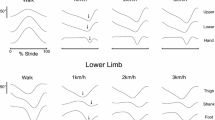Abstract
The law of intersegmental coordination is a kinematic law that describes the coordination patterns among the elevation angles of the lower limb segments during locomotion (Borghese et al. in J Physiol 494:863–879, 1996). This coordination pattern reduces the number of degrees of freedom of the lower limb to two, i.e. the elevation angles covary along a plane in angular space. The properties of the plane that constrains the time course of the elevation angles have been extensively studied, and its orientation was found to be correlated with gait velocity and energy expenditure (Bianchi et al. in J Neurophysiol 79:2155–2170, 1998). Here, we present a mathematical model that represents the rotations of the elevation angles in terms of simple oscillators with appropriate phase shifts between them. The model explains what requirements the time courses of the elevation angles must fulfill in order for the angular covariation relationship to be planar. Moreover, an analytical formulation is proposed for both the orientation of the plane and for the eccentricity of the nearly elliptical shape that is generated within this plane, in terms of the amplitudes and relative phases of the first harmonics of the segments elevation angles. The model presented here sheds some new light on the possible interactions among the Central Pattern Generators possibly underlying the control of biped locomotion. The model precisely specifies how any two segments in the limb interact, and how a change in gait velocity affects the orientation of the intersegmental coordination plane mainly through a change in phase shifts between the segments. Implications of this study with respect to neural control of locomotion and other motor activities are discussed.







Similar content being viewed by others
Notes
Direction cosines refer to the components of a unit vector which represents its orientation. The value of each component is equal to the cosine of the angle formed by the unit vector with the respective basis vector.
Matlab Curve Fitting Toolbox.
Similar to the computation done for finding α above.
References
Anton H (1994) Elementary linear algebra, 7th edn. Wiley, New York, pp 483–493
Bianchi L, Angelini D, Orani GP, Lacquaniti F (1998) Kinematic coordination in human gait: relation to mechanical energy cost. J Neurophysiol 79:2155–2170
Borghese NA, Bianchi L, Lacquaniti F (1996) Kinematic determinants of human locomotion. J Physiol 494:863–879
Capaday C (2002) The special nature of human walking and its neural control. Trends Neurosic 25(7):370–376
Cheron G, Bouillot E, Dan B, Bengoetxea A, Draye J-P, Lacquaniti F (2001) Development of a kinetic coordination pattern in toddler locomotion: planar covariation. Exp Brain Res 137:455–466
Courtine G, Schiepati M (2004) Tuning of basic coordination pattern constructs straight-ahead and curved walking in humans. J Neurophysiol 91:1524–1535
Delcomyn F (1980) Neural basis of rhythmic behavior in animals. Science 210(31):492–498
Duysens J, Van de Crommert HWAA (1998) Neural control of locomotion; Part 1: the central pattern generator from cats to humans. Gait Posture 7:131–141
Grillner S (1981) Control of locomotion in bipeds, tetrapods, and fish. In: Handbook of physiology, the nervous system. American Physiological Society, Bethesda, pp 1179–1236
Grillner S (1996) Neural networks for vertebrate locomotion. Sci Am 274(1):64–69
Grillner S, Wallen P, Brodin L, Lansner A (1991) Neuronal network generating locomotor behavior in lamprey: circuitry, transmitters, membrane properties, and simulation. Annu Rev Neurosci 14:169–199
Hicheur H, Terekhov AV, Berthoz A (2006) Intersegmental coordination during human locomotion: does planar covariation of elevation angles reflect central constraints? J Neurophysiol 96:1406–1419
Ivanenko YP, Grasso R, Macellari V, Lacquaniti F (2002) Control of foot trajectory in human locomotion: role of ground contact forces in simultaed reduced gravity. J Neurophysiol 87:3070–3089
Ivanenko YP, Dominici N, Cappellini G, Lacquaniti F (2005a) Kinematics in newly walking toddlers does not depend upon postural stability. J Neurophysiol 94:754–763
Ivanenko YP, Cappelini G, Dominici N, Poppele RE, Lacquaniti F (2005b) Coordination of locomotion with voluntary movements in humans. J Neurosci 25:7238–7253
Ivanenko YP, Cappelini G, Dominici N, Poppele RE, Lacquaniti F (2007) Modular control of limb movements during human locomotion. J Neurophysiol 27:11149–11161
Ivanenko YP, d’Avella A, Poppele RE, Lacquaniti F (2008) On the origin of planar covariation of elevation angles during human locomotion. J Neurophysiol 99:1890–1898
Lacquaniti F, Grasso R, Zago M (1999) Motor patterns in walking. News Physiol Sci 14:168–174
Marker Placement Protocols [Online] (2006) Biomechanics Research Group, Inc. http://www.lifemodeler.com/LM_Manual/A_motion.htm 30 March 2006
Mussa-Ivaldi F, Solla S (2004) Neural primitives for motion control. IEEE J Ocean Eng 29:640–650
Pearson KG (1993) Common principles of motor control in vertebrates and invertebrates. Annu Rev Neurosci 16:265–297
Pearson KG (2000) Neural adaptation in the generation of rhythmic behavior. Annu Rev Physiol 62:723–753
Taga G, Yamaguchi Y, Shimizu H (1991) Self-organized control of bipedal locomotion by neural oscillators in unpredictable environment. Biol Cybern 65:147–159
Vaughan CL, Davis BL, O’Connor JC (1999) Dynamics of human gait, 2nd edn. Kiboho publishers, Cape Town
Yefimov NV (1964) Quadratic forms and matrices. Academic Press, New York, pp 1–27
Acknowledgments
This research was supported in part by the HFSP Grant # RGP0054/2004-C and by a grant from the European Commission (COBOL). The Tuebingen team was also supported by the Volkswagenstiftung. Tamar Flash is the incumbent of the Dr. Hymie Moross Professorial Chair.
Author information
Authors and Affiliations
Corresponding author
Electronic supplementary material
Below is the link to the electronic supplementary material.
Rights and permissions
About this article
Cite this article
Barliya, A., Omlor, L., Giese, M.A. et al. An analytical formulation of the law of intersegmental coordination during human locomotion. Exp Brain Res 193, 371–385 (2009). https://doi.org/10.1007/s00221-008-1633-0
Received:
Accepted:
Published:
Issue Date:
DOI: https://doi.org/10.1007/s00221-008-1633-0




